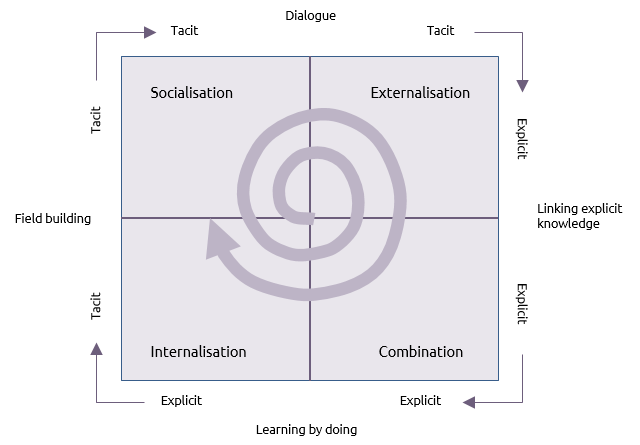Ikujiro Nonaka and Hirotaka Takeuchi set out their spiral model of knowledge management in 19951.
Sometimes known as the ‘SECI model’ it addresses the links between tacit and explicit knowledge and illustrates how knowledge is expanded and enhanced through the process of converting tacit knowledge to explicit knowledge and back again.

- Socialisation
-
Tacit knowledge is held by individuals and is constantly enhanced by their experiences. Socialisation is about the sharing of tacit knowledge through communication and shared experience. This should happen every time a P3 management team meet and is also a key factor in the relationship between the manager and the sponsor.
Outside the normal day to day management of individual projects and programmes, an organisation may promote the process of sharing tacit information through communities of practice or support for coaching and mentoring.
- Externalisation
-
Tacit knowledge is converted to explicit knowledge by developing models and describing concepts. In effect this is what Praxis and other guides do by documenting tacit knowledge in a physical, readable form. This explicit and sometimes theoretical knowledge form a foundation for the creation of new knowledge.
- Combination
-
When knowledge is explicit, it can be combined. Once again, Praxis is a good example of this combination. It takes explicit knowledge from a variety of published sources, including project management bodies of knowledge, methodologies, competency frameworks and capability maturity models and combines these into something that is hopefully greater than the sum of its parts.
- Internalisation
-
This occurs when the individual understands the explicit knowledge and it becomes part of their normal behaviour. This builds the individual’s ability to develop new tacit knowledge which then comes back to the principle of socialisation.
The spiral in the model indicates that each time knowledge goes around this loop it is expanded and enhanced. This embodies the principle of Praxis as an open framework that evolves through contributions by the P3M community.
- Nonaka, I; Takeuchi, H (1995), The knowledge creating company: how Japanese companies create the dynamics of innovation, Oxford University Press, New York





